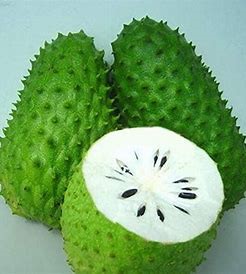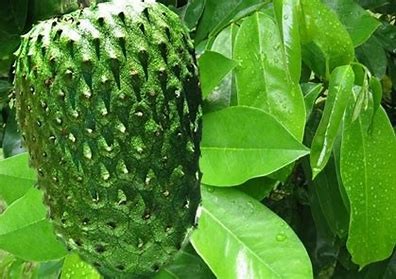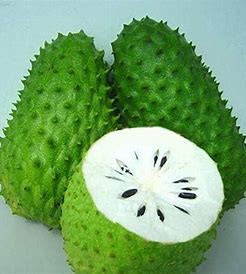FOOD AS MEDICINE- SOURSOP

Annona muricata
Growing up back in the days, I still remember our compound in the village, each woman had her little space at the back of her hut where they practiced home vegetable farming. Most times, in addition to the vegetables, they added fruit trees like Pawpaw, Ube (African native Pear), Orange and others. Particularly striking is the fact that in all the back yards, the women not only planted the soursop tree, but consciously or unconsciously they had them lined up along the demarcating lines thus fencing- in and securing the backyard spaces.
When soursops are in season, especially during the rains, they ripen and fall down bursting, exposing, and scattering the white marshy fibrous contents! OMG, how we loathed them at the time, making us eat them was like punishment, not only because of the soggy nature, but because it was associated (amongst our pears) with weakness! Any child that that appeared not –too strong was bullied and name- called chop-chop (that’s what we use to call it then)
Little did we ever believe that many years after, this much disliked fruit called chop-chop/shawanchop in Igbo, soursop in English, and Annona Muricata, as botanical name, would become the much sought -after superfood today. Other names of this great fruit include, Graviola or guyabano in Hispanic, Custard Apple in America, Brazilian Pawpaw, ebo or apekan in Yoruba, Fasadarur or tuwon biri in Hausa.
Though the origin of the Annona muricata evergreen tree is not exactly known, it is nonetheless said to have its origin from the Americas, Caribbean, and some parts of Africa. Despite this origin, the tree is widely and naturally propagated from the seeds and can be easily seen in almost every neighbourhood that has high humidity as temperatures and warm winters. It is said that cold weathers cause damage to the leaves and branches.
The tree of Annona muricata is usually small and straight and can grow up to 30 feet with oblong, broad, ever green leaves, and hairy young branches. The flowers have yellowish petals, thick and covered with long soft hairs both on the outside and inside.
The young fruits are heart/oval shaped, stony, greenish, and spiky, however when ripen, they are soft, marshy, and the colour changes to yellowish green. It weighs about 5kg when fully matured, creamy, fibrous white and has an inviting aromatic smell with a ting of mango, pineapple, and banana flavours. It is mostly eaten raw in different ways and different places for instance, can be cut up into small lateral chunks and eaten, can be strained to make custard, added to smoothies, made into ice cream as a healthy replacement of conventional sugar laden ones or made into and drinks with a combination of other fruits and a dash of lemon, or juiced just straight depending on individual choice.
Soursop can also be used as milk by blending the pulp with some water, straining, and adding other ingredients like banana for fuller texture. Some people prefer to use it as a salad dressing in preference to brands like Mayo and a good alkaline vegan alternative. To get the desired texture, it is usually pureed and added with a ting of lemon for flavour, and it’s good to go for a delicious dressing.
The unripe fruit can likewise be fried or baked. Just cut it up and fetch out the white part, remove seeds then fry with any healthy oil for a couple of minutes. Preferably sprinkle some oil on it and bake for about 30 minutes and put aside for snacking.
In addition to the edible uses, soursop has a lot of medicinal values ranging from the fruits, leaves, roots, and in some traditions the seeds; though the seeds are said to be poisonous and contain a substance called annonacin said to be capable of causing Parkinsons disease. The fruit has a lot of minerals like calcium, magnesium, iron and vitamin c. It is said that the vitamin c content in one cup of the pulp is more than half the recommended adult dose per day.
It is widely opined that this fruit is an alternative to cancer treatment, however research has it that most investigations are currently limited to test-tube studies. According to Healthline, a health and wellness online newsletter, “some studies have found that soursop could potentially help eliminate cancer cells”.
They further stated that, “One test-tube study treated breast cancer cells with soursop extract. It was able to reduce tumor size, kill off cancer cells and enhance the activity of the immune system; Another test-tube study looked at the effects of soursop extract on leukemia cells, which was found to stop the growth and formation of cancer cells”
Further studies reveal that the juice of the ripe fruit is diuretic and can help in remedying urinary conditions, taken on empty stomach, the juice is alleged to relieve liver ailment and even leprosy. The crushed immature fruits are decocted for solution against dysentery.
Extract from the leaves either as juice or tea is said to be highly beneficial to general wellness and remedy for some chronic disease conditions. For instance, some laboratory studies suggest that consumption of the juice from the leaf or taken as herbal tea can target and kill cancer cells that hitherto cannot be reached via chemotherapy. It can also serve as a sedative, as an analgesic and antispasmodic as claimed in Esmeraldas Province, Ecuador. In Africa, it is given to children with fever, and they are also bathed with it, to alleviate the condition. It is also said that it can improve the metabolic health of the body due to the content of phytochemicals.
It is claimed that the leaves broken, soaked in water added with a squeeze of some drops of lemon, given to a drunken person and some rubbed on his forehead, would sober him up in a bit. It is as well believed to have sedative effect especially in Antilles, Netherland, and West Indies where the leaves are usually put under the pillow or tossed on the bed to induce a good night’s sleep.
The young roots when decocted is claimed to alleviate gall bladder challenges, indigestion, coughs, catarrh, able to check vomiting and aid child delivery
The tincture from the bark is said to serve as antidote for poisoning. It is not surprising then to see online sellers marketing Annona muricata products but under the name, graviola . Some of the products include fresh fruit packaged fruit pulp tincture extract from leaves and fruit powdered leaf bitters capsules and tablets dried whole leaves tea bags.



